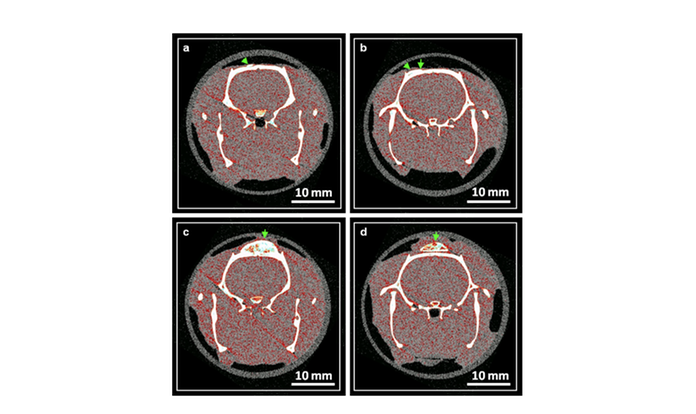Regenerative medicine

Our project
Injectable hydrogels as carriers of biotherapeutics for in vivo bone regeneration
Figure above: Representative peripheral CT indicating bone formation using BMP-2 loaded hydrogel after 8 weeks in rat calvaria. (a) subperiosteal injection without rhBMP-2; (b) subperiosteal injection with 5 µg/mL rhBMP-2; (c) subperiosteal injection with 150 µg/mL rhBMP-2; (d) subcutaneous injection with 150 µg/mL rhBMP-2. Arrows indicate the location of newly formed bone.
Three-dimensional (3D) scaffolds are commonly used in tissue engineering, which has a highly porous structure that allows the encapsulation of cells and diffusion of biomolecules, oxygen and nutrients. These scaffolds are normally designed to have mechanical properties that mimic the actual in vivo microenvironment where cells interact. In our research, we validate the potential of chemically crosslinked hydrogels for in vivo delivery of clinically used protein. Recombinant human bone morphogenetic protein 2 (rhBMP-2) is an FDA approved growth factor that induces differentiation of stem cells and progenitor cells towards the bone tissue. This protein, however, had a very short half-life with t1/2 = 6.7 min in non-human primates after IV administration. Our research is focused on designing materials that can improve BMP-2 stability and bioactivity. Such a strategy would allow reducing dosage, which will mitigate the dose-dependent adverse side effects of such proteins. We have recently shown that by engineering the HA-based hydrogels having acid pH (pH ≈ 4.5) significantly increases the Van der Waal’s interactions with the protein, even after neutralization of the hydrogel under physiological conditions. Such stabilization of rhBMP-2 not only controls its release but also improve the pharmacokinetic and pharmacodynamic profiles of the drug molecules.
Publications
- Yan, H. J.; Casalini, T.; Hulsart-Billström, G.; Wang, S.; Oommen, O. P.; Salvalaglio, M.; Larsson, S.; Hilborn, J.; Varghese, O. P. Synthetic design of growth factor sequestering extracellular matrix mimetic hydrogel for promoting in vivo bone formation. Biomaterials 2018, 161, 190-202. http://www.sciencedirect.com/science/article/pii/S0142961218300619
- Kisiel, M.; Ventura, M.; Oommen, O. P.; George, A.; Walboomers, X. F.; Hilborn, J.; Varghese, O. P. Critical assessment of rhBMP-2 mediated bone induction: An in vitro and in vivo evaluation. J. Control. Release 2012, 162, 646-653. http://www.sciencedirect.com/science/article/pii/S0168365912006141
- Martínez-Sanz, E.; Ossipov, D. A.; Hilborn, J.; Larsson, S.; Jonsson, K. B.; Varghese, O. P. Bone reservoir: Injectable hyaluronic acid hydrogel for minimal invasive bone augmentation. J. Control. Release 2011, 152, 232-240. http://www.sciencedirect.com/science/article/pii/S0168365911000873
